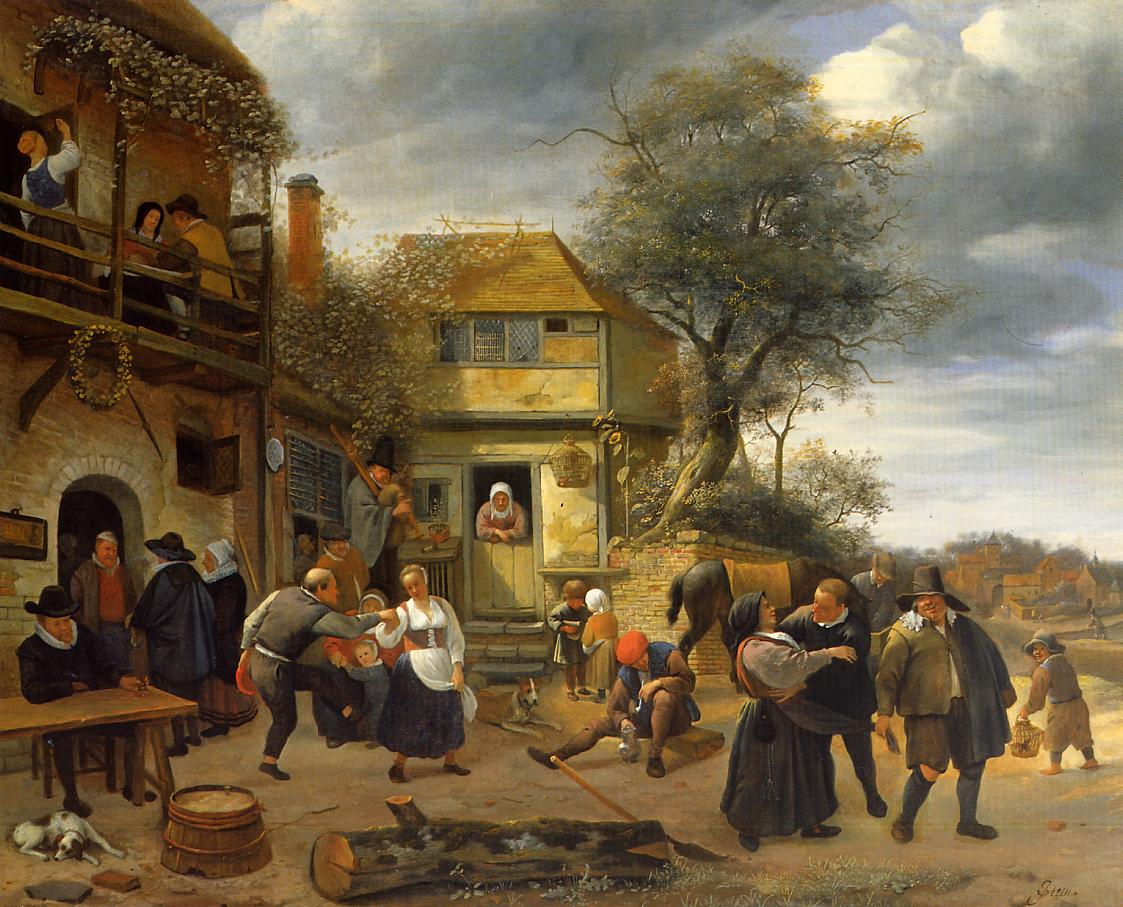|
The Feast Of Saint Nicholas
''The Feast of Saint Nicholas'' (Dutch: ''Het Sint-Nicolaasfeest'') is an oil-on-canvas painting executed c. 1665–1668 by Netherlands, Dutch master Jan Steen, which is now in the Rijksmuseum in Amsterdam. It measures 82 x 70.5 cm. The picture, painted in the chaotic Jan Steen style, depicts a family at home on December 5, the night celebrated in the Netherlands as the Feast of Saint Nicholas, or Sinterklaas. Jan Steen and his contemporaries Jan Steen was a Dutch genre art, genre painter of the 17th century. Dutch painting of the time, including the landscapes of Aelbert Cuyp and Jacob van Ruisdael, show a rustic intimacy that carried over into genre paintings of domestic scenes. The paintings of Jan Vermeer and Jan Steen detail the same sense of comfort in scenes from daily household life. As the Dutch economy thrived and the middle class of wealthy merchants grew, such domestic paintings rose in popularity. As members of the middle class became the new patrons of art, the t ... [...More Info...] [...Related Items...] OR: [Wikipedia] [Google] [Baidu] |
Jan Steen
Jan Havickszoon Steen (c. 1626 – buried 3 February 1679) was a Dutch Golden Age painter, one of the leading genre painters of the 17th century. His works are known for their psychological insight, sense of humour and abundance of colour. Life Steen was born in Leiden, a town in Southern Holland, where his well-to-do, Catholic family were brewers who ran the tavern ''The Red Halbert'' for two generations. Steen's father even leased him a brewery of his own in Delft from the years 1654 until 1657. He was the eldest of eight or more children. Like his even more famous contemporary Rembrandt van Rijn, Jan Steen attended the Latin school and became a student in Leiden. Though no official records of Steen's artistic training are preserved, contemporary sources tell us he received his painterly education from three men, Nicolaes Knupfer (1603–1660), a German painter of historical and figurative scenes in Utrecht, Adriaen van Ostade, and Jan van Goyen, who would later become ... [...More Info...] [...Related Items...] OR: [Wikipedia] [Google] [Baidu] |
Jan Steen - The Feast Of St
Jan, JaN or JAN may refer to: Acronyms * Jackson, Mississippi (Amtrak station), US, Amtrak station code JAN * Jackson-Evers International Airport, Mississippi, US, IATA code * Jabhat al-Nusra (JaN), a Syrian militant group * Japanese Article Number, a barcode standard compatible with EAN * Japanese Accepted Name, a Japanese nonproprietary drug name * Job Accommodation Network, US, for people with disabilities * ''Joint Army-Navy'', US standards for electronic color codes, etc. * ''Journal of Advanced Nursing'' Personal name * Jan (name), male variant of ''John'', female shortened form of ''Janet'' and ''Janice'' * Jan (Persian name), Persian word meaning 'life', 'soul', 'dear'; also used as a name * Ran (surname), romanized from Mandarin as Jan in Wade–Giles * Ján, Slovak name Other uses * January, as an abbreviation for the first month of the year in the Gregorian calendar * Jan (cards), a term in some card games when a player loses without taking any tricks or scoring a mini ... [...More Info...] [...Related Items...] OR: [Wikipedia] [Google] [Baidu] |
Paintings In The Collection Of The Rijksmuseum
Painting is the practice of applying paint, pigment, color or other medium to a solid surface (called the "matrix" or "support"). The medium is commonly applied to the base with a brush, but other implements, such as knives, sponges, and airbrushes, can be used. In art, the term ''painting ''describes both the act and the result of the action (the final work is called "a painting"). The support for paintings includes such surfaces as walls, paper, canvas, wood, glass, lacquer, pottery, leaf, copper and concrete, and the painting may incorporate multiple other materials, including sand, clay, paper, plaster, gold leaf, and even whole objects. Painting is an important form in the visual arts, bringing in elements such as drawing, composition, gesture (as in gestural painting), narration (as in narrative art), and abstraction (as in abstract art). Paintings can be naturalistic and representational (as in still life and landscape painting), photographic, abstract, nar ... [...More Info...] [...Related Items...] OR: [Wikipedia] [Google] [Baidu] |
1660s Paintings
Year 166 ( CLXVI) was a common year starting on Tuesday (link will display the full calendar) of the Julian calendar. At the time, it was known as the Year of the Consulship of Pudens and Pollio (or, less frequently, year 919 '' Ab urbe condita''). The denomination 166 for this year has been used since the early medieval period, when the Anno Domini calendar era became the prevalent method in Europe for naming years. Events By place Roman Empire * Dacia is invaded by barbarians. * Conflict erupts on the Danube frontier between Rome and the Germanic tribe of the Marcomanni. * Emperor Marcus Aurelius appoints his sons Commodus and Marcus Annius Verus as co-rulers (Caesar), while he and Lucius Verus travel to Germany. * End of the war with Parthia: The Parthians leave Armenia and eastern Mesopotamia, which both become Roman protectorates. * A plague (possibly small pox) comes from the East and spreads throughout the Roman Empire, lasting for roughly twenty years. * ... [...More Info...] [...Related Items...] OR: [Wikipedia] [Google] [Baidu] |
Century Magazine/Volume 47/Issue 2/Old Dutch Masters
A century is a period of 100 years. Centuries are numbered ordinally in English and many other languages. The word ''century'' comes from the Latin ''centum'', meaning ''one hundred''. ''Century'' is sometimes abbreviated as c. A centennial or centenary is a hundredth anniversary, or a celebration of this, typically the remembrance of an event which took place a hundred years earlier. Start and end of centuries Although a century can mean any arbitrary period of 100 years, there are two viewpoints on the nature of standard centuries. One is based on strict construction, while the other is based on popular perception. According to the strict construction, the 1st century AD began with AD 1 and ended with AD 100, the 2nd century spanning the years 101 to 200, with the same pattern continuing onward. In this model, the ''n''-th century starts with the year that ends with "01", and ends with the year that ends with "00"; for example, the 20th century comprises the years 1901 t ... [...More Info...] [...Related Items...] OR: [Wikipedia] [Google] [Baidu] |
Marriage A La Mode
Marriage, also called matrimony or wedlock, is a culturally and often legally recognized union between people called spouses. It establishes rights and obligations between them, as well as between them and their children, and between them and their in-laws. It is considered a cultural universal, but the definition of marriage varies between cultures and religions, and over time. Typically, it is an institution in which interpersonal relationships, usually sexual, are acknowledged or sanctioned. In some cultures, marriage is recommended or considered to be compulsory before pursuing any sexual activity. A marriage ceremony is called a wedding. Individuals may marry for several reasons, including legal, social, libidinal, emotional, financial, spiritual, and religious purposes. Whom they marry may be influenced by gender, socially determined rules of incest, prescriptive marriage rules, parental choice, and individual desire. In some areas of the world, arranged marr ... [...More Info...] [...Related Items...] OR: [Wikipedia] [Google] [Baidu] |
William Hogarth
William Hogarth (; 10 November 1697 – 26 October 1764) was an English painter, engraver, pictorial satirist, social critic, editorial cartoonist and occasional writer on art. His work ranges from realistic portraiture to comic strip-like series of pictures called "modern moral subjects", and he is perhaps best known for his series ''A Harlot's Progress'', ''A Rake's Progress'' and '' Marriage A-la-Mode''. Knowledge of his work is so pervasive that satirical political illustrations in this style are often referred to as "Hogarthian". Hogarth was born in London to a lower-middle-class family. In his youth he took up an apprenticeship with an engraver, but did not complete the apprenticeship. His father underwent periods of mixed fortune, and was at one time imprisoned in lieu of outstanding debts, an event that is thought to have informed William's paintings and prints with a hard edge. Influenced by French and Italian painting and engraving, Hogarth's works are mostly sat ... [...More Info...] [...Related Items...] OR: [Wikipedia] [Google] [Baidu] |
Gingerbread Man
A gingerbread man or a Gingerbread man cookie is a biscuit or cookie made from gingerbread, usually in the shape of a stylized form / caricature of a human being, although other shapes, especially seasonal themes (Christmas, Halloween, Easter, etc.) and characters are common too. History Gingerbread dates from the 15th century, and figurative biscuit-making was practised in the 16th century. The first documented instance of figure-shaped gingerbread biscuits was at the court of Elizabeth I of England. She had the gingerbread figures made and presented in the likeness of some of her important guests which brought the human shape of the gingerbread cookies. Characteristics Most gingerbread men share a roughly humanoid shape, with stubby feet and no fingers. Many gingerbread men have a face, though whether the features are indentations within the face itself or other candies stuck on with icing or chocolate varies from recipe to recipe. Other decorations are common; hair, shir ... [...More Info...] [...Related Items...] OR: [Wikipedia] [Google] [Baidu] |
Jan Vermeer
Johannes Vermeer ( , , see below; also known as Jan Vermeer; October 1632 – 15 December 1675) was a Dutch Baroque Period painter who specialized in domestic interior scenes of middle-class life. During his lifetime, he was a moderately successful provincial genre painter, recognized in Delft and The Hague. Nonetheless, he produced relatively few paintings and evidently was not wealthy, leaving his wife and children in debt at his death. Vermeer worked slowly and with great care, and frequently used very expensive pigments. He is particularly renowned for his masterly treatment and use of light in his work. "Almost all his paintings", Hans Koningsberger wrote, "are apparently set in two smallish rooms in his house in Delft; they show the same furniture and decorations in various arrangements and they often portray the same people, mostly women." His modest celebrity gave way to obscurity after his death. He was barely mentioned in Arnold Houbraken's major source book on 17 ... [...More Info...] [...Related Items...] OR: [Wikipedia] [Google] [Baidu] |
Oil On Canvas
Oil painting is the process of painting with pigments with a medium of drying oil as the binder. It has been the most common technique for artistic painting on wood panel or canvas for several centuries, spreading from Europe to the rest of the world. The advantages of oil for painting images include "greater flexibility, richer and denser colour, the use of layers, and a wider range from light to dark". But the process is slower, especially when one layer of paint needs to be allowed to dry before another is applied. The oldest known oil paintings were created by Buddhist artists in Afghanistan and date back to the 7th century AD. The technique of binding pigments in oil was later brought to Europe in the 15th century, about 900 years later. The adoption of oil paint by Europeans began with Early Netherlandish painting in Northern Europe, and by the height of the Renaissance, oil painting techniques had almost completely replaced the use of tempera paints in the majority o ... [...More Info...] [...Related Items...] OR: [Wikipedia] [Google] [Baidu] |
_-_WGA21723.jpg)






